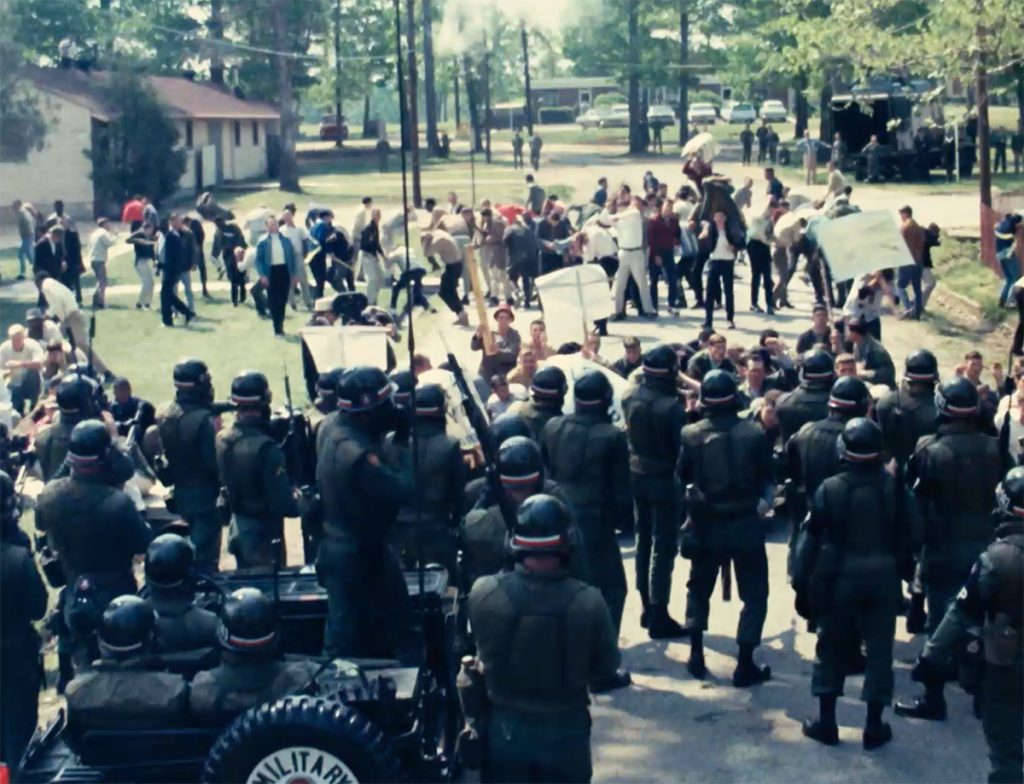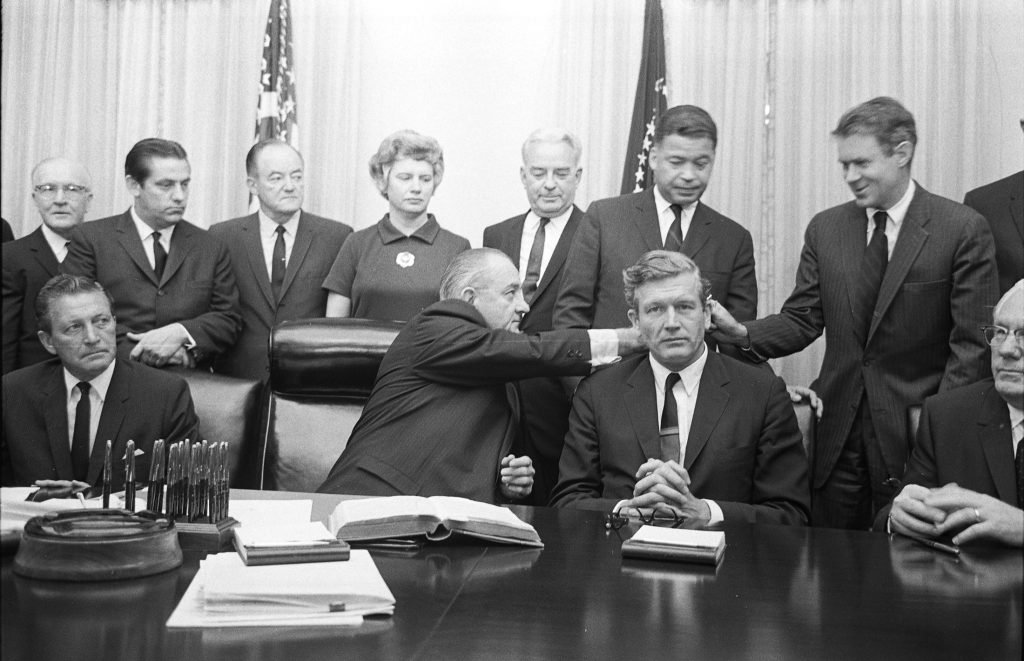All Images Courtesy of Magnolia Pictures
“The making of this film was really a long process of trying to figure out what the Riotsville footage is, on many levels. I was so shaken by what I saw in it, and also so drawn to it. I spent the next six years trying to figure it out: What it said about the 1960s, and also how it speaks to right now.” – Director Sierra Pettengill
Award-Winning Director Sierra Pettengill’s RIOTSVILLE, USA is riveting story telling about the truth, the whole truth and nothing but the truth about the militarization of police agencies around the country during the civil rights and anti-Vietnam War movements.
A militant artisan cum documentary filmmaker with a prodigious palette, she fuses archival national news media reportage from the late 1960s with archival U.S. military film and video footage from that same period, exposing the insidious nature of the militarization.
Thus, her bravura, exquisitely poetic, cinematic storytelling reveals the heart and soul of that tactical mobilization which was to crush the inner city rallies and rebellions of Black people daring to take to the streets to fight racist oppression. “Elizabeth Hinton, author of America on Fire,” Pettengill says in the film’s production notes,” makes the great point that the 60s created this image of riots as being a fundamentally Black phenomenon, when factually, most riots in this country have been white vigilantes, many times playing out violence against Black citizens which is something that we have very much seen in last few years as well, of course.”
She makes clear that she and her filmmaking collaborators “wanted to underline the fact that this massive militarization of the police as a reaction to Black riots is not incidental. To be able to show the military recreating and rehearsing something and then see it play out in real time shifts the narrative: Instead of the police and military responding to an outbreak of violence, it’s presented as an attack on civilians by the police backed by a massive explosion of money and interest towards repressing Black rebellion.”
Rebellions and uprisings of citizens facing off against and fighting racism scare the bejesus out of The Powers That Be which are capable, of course, and willing, of course, as history has shown, to do really sinister things by any means necessary – extralegal and illegal because of that paranoia.
The haunting, spectral-like scenes of training exercises with mock battles in RIOTSVILLE, USA are as disturbing as they are riveting. The sham, imitation mock towns where the mobilization training took place were named Riotsvilles by the U.S. Army and were built after the release of the 1968 report by President Lyndon B. Johnson’s National Advisory Commission on Civil Disorders known as the Kerner Commission.
Because of the commission’s findings that poverty and institutional racism were the driving forces of inner-city violence and not the usually cited bugaboos of “outside” troublemakers and instigators, there was a general loathing of the commission’s findings; the report was pretty much rejected by America in general. President Johnson, of course, wasn’t pleased with the findings.
[This reviewer recalls how years ago his editors at the Democrat & Chronicle newspaper, in Rochester, New York, edited out excerpts of the findings included in one of my police beat articles about racial tension between police, predominately White, and Rochester’s inner city Black residents. They didn’t like me using excerpts from the report as source information. I recall saying the editing out was “policing out” censoring of information that provided additional context.
The D&C morning newspaper at that time was one in the expansive chain of Gannett newspapers, and I cite this now an example of news editorial decisions and policies in that took place in corporate newsrooms regarding the Kerner Commission findings – and also because Rochester was the scene of incredible violence.]
Burning, battering and ransacking property, raging crowds created bloody chaos where many civilians were shot and beaten if not killed. Pent-up frustrations in many poor African-American neighborhoods during the mid-to-late-1960s, set off violence and rampage with the National guard and other police agencies doing most of the carnage. According to the film’s production notes, the Harvest of American Racism – The Political Meaning of Violence in the Summer of 1967, written by a group of Kerner Commission staff researchers, provided a political context, identifying what was commonly referred to as riots as rebellions instead, and linked them to global anti-colonial struggles. The findings were rejected and removed from the final report.
“White society is deeply implicated in the ghetto. White institutions created it, white institutions maintain it, and white society condones it,” according to the introduction of the Kerner Commission. The report denied that any “conspiracy” was at work in the so-called “riots;” and instead identifies predatory policing practices, discriminatory housing, employment, education, and biased media coverage.
The report called for “unprecedented levels of funding” into anti-poverty programs for disadvantaged and segregated communities. That policies called for in the declaration were never actualized, though large sums of federal money were given to police departments.
Many Americans, according to the March 2018 Smithsonian article, and a glut of other reports, news and scholarly, show how the “riots” were blamed on “outside agitators” and young black men, who represented the largest and most visible group of rioters. Yet, the Kerner Commission shot those assumptions down, stating that white racism, not black rage, was the cause of the urban American turmoil.
Above: President Lyndon Baines Johnson with some members of the National Advisory Commission on Civil Disorders in the Cabinet Room of the White House. Johnson failed to get the Commission to substantiate his belief that “outside agitators” were the main cause of protests. The Commission report though widely disseminated, ended up virtually in the trash bin. Picture Source: Wikipedia.
RIOTSVILLE, USA is sublimely kaleidoscopic in content and context, so kaleidoscopic that significant historical moments in the late ’60s (leading to movies, TV series, documentaries, books, book chapters, in-depth literary pieces and more) in sync with the premises and themes of Pettengill’s documentary are so profuse and thick that they are only noted here as topics, such as The Miami Riots, Chicago Democratic National Convention, the Republican National Convention, the Assassination of Martin Luther King, et. al.
A Succinct Description How This Documentary Was Made, Based on Production Notes and Other Information and Edited for Style
1:31 Minutes Long, Six Years in the Making
Sierra Pettengill says she has worked extensively as an archival researcher for filmmakers and artists for the last 15 years, and as director of archival films, her work has focused on contending with the ways “we can locate and trace structural power and white supremacism within the archives.” This director is in a very rare class. There are lots of documentarians who use archival material in their films but it’s rare to find an archival documentarian of considerable stature who makes films with archival footage and images as their exclusive main content.
Pettengill’s says her goal as a filmmaker is to re-present historical material that compels attention to the past and reflect upon the present and the real connection, and “interrogate” the unique ways that moving images can transmit history.
“Making this film was about more than detailing the precise governmental and political machinations that lead to this specific training program. It was about making sense of the Riotsville footage; for me that is what the filmmaking process always is.”
“How do you situate Riotsville within the legacy of 1968, reconciling living memory and mythology? How do you situate it within the life of the communities most affected by the state violence the performancesat Riotsville are illustrating, and within the activism organizing to oppose it? And crucially, how do you situate it within a nation founded on white supremacism, determined to launch a war against its Black citizens, on a loop for hundreds of years?”
“These questions informed the form and shape of the film; a mapping of structural forces that could not seem more urgent in 2022, with all the violence and possibility it contains.”
“It’s difficult to watch these overwhelming forces of oppression take shape … but that’s actually, perhaps paradoxically, where I also find the hope. In watching the formation of these forces, you realize how they’re all constructed. We take the world we live in as an inevitability. What I find really empowering, it’s all constructed and, thus, can be deconstructed.”
“There is this idea that these movements failed, that protests failed, that activists weren’t practical enough. I wanted to show all the forces that aligned against them. We end the film with the visionary architecture of June Jordan. If an oppressive system like the one we see today can be constructed, something like Jordan’s dream of a humane Harlem can too. Hopefully, this film helps us see what we need to overcome to get there.”
Director Pettengill
For this film, almost more than for any I’ve made before, having the context for this type of archival material felt like a crucial and necessary element. My collaborators Tobi Haslett, who wrote the voiceover, and composer Jace Clayton were key in this regard.
Tobi is a writer that I’d long admired, both for his writing on radical movements and his writing on essay films. He has a really sharp and specific voice, and he brought a deep historical knowledge, provided a tether to the present moment, and brought real poetry to the narration.
The sections where his writing appears are all digitally altered, calling attention to their own materials. Jace Clayton’s musical score also underlines the artifice of the archival material. He composed the score on analog synthesizers, which are of the era and feel very grounded in the material, but also sometimes sound really alien.
“Elizabeth Hinton, author of America on Fire, makes the great point that the 60s created this image of riots as being a fundamentally Black phenomenon, when factually, most riots in this country have been white vigilantes, many times playing out violence against Black citizens (which is something that we have very much seen in last few years as well, of course).
We wanted to underline the fact that this massive militarization of the police as a reaction to Black riots is not incidental. To be able to show the military recreating and rehearsing something and then see it play out in real time shifts the narrative: Instead of the police and military responding to an outbreak of violence, it’s presented as an attack on civilians by the police backed by a massive explosion of money and interest towards repressing Black rebellion.
The public television media you employ provides a broader perspective on the narrative of civil unrest vs law and order. We were trying to deal with this dissonance, where 1968 seems both pretty modern and also very far away. Finding the Public Broadcast Laboratory (PBL) program really drove that home. The PBL clips engage with the issues underlying the unrest so much more deeply
We wanted to present it in a way that mimicked our own reactions to watching and listening to the discourse that was happening publicly on PBL, shown nationally via PBS. The Kerner Commission post-mortem, in particular, with Bayard Rustin and Kenneth Clark, is so far ahead of the rest of the conversation that’s happening anywhere else on broadcast television.
The PBL clips show the very reasoned debates and policy demands that underlie the riots that erupted in the late ‘60s, the root issues that were even recognized by the Kerner commission. It’s like Reverend Gibson in the scene in Miami towards the end of the film. He sums it up perfectly: “We ask, we ask, and we ask and you promise, you promise, you promise.” That’s what the film is driving at. You see these incredibly on-point, reasoned conversations happening, over and over and over, and they are ignored and ignored and ignored.
Ultimately, how can what happen in Liberty City possibly be seen as some unreasonable act of violence, you know? Even at the very end, we show a black reporter, Bob Reid, who works for WTVJ in Miami, and he’s asked the question by his white colleague: “Why are these riots happening?”
And Reid gives a very thoughtful answer about how they can’t take it any longer. And the white reporter’s response is, “well, I guess we’ll never know the reason.” He just ignores him and carries on in willful ignorance. That’s how you should feel – the answers have been provided all along. You use Frederick Douglass Kirkpatrick’s performance of “Burn Baby Burn” to mark the end of this experiment in public television and also the death of MLK.
The editor Nels Bangerter found that performance, and the decision to play it in full is something that has been in the film since his very first draft of the cut. We wanted to give unbroken time to that expression, which feels like a rare thing to be on television in the first place. It’s just an incredibly moving performance.
It’s a hard one to intellectualize, but it felt like an emotional necessity to have a structural break to mark the scale of the loss of Rev. Martin Luther King Jr. To look and listen and feel, for an extended period of time. Some moments are larger than others, and the weight of that moment should be reflected in the time-space of the film. At what point did you know you wanted to end with the Republican National Convention in Miami and the riot in Liberty City?
We were trying to kind of reverse a certain set of assumptions about the ‘60s. The Miami RNC is just not part of our historical memory in the USA. The Chicago DNC looms large in the mythology of the era – it’s even gotten the Aaron Sorkin treatment – but it’s important to
remember that the RNC is largely unexplored, and it also represents the side that won. It has all these characters that will shape the 50 years to come. Reagan rides in.
We wondered if what happened in Liberty City might be more relevant to look at than what happened during Chicago.The goal of waiting until the final moments of the film for there to be images of Black people rebelling against their circumstances was to fully equip the audience to be able to look at that footage in a different way. Right after we move out into the streets of Miami, Tobi Haslett’s beautiful narration quotes Frantz Fanon about how the colonized dream of strength, of running, jumping, and flying. There is still agency.
And the footage of the rebellion in Liberty City Miamishould be viewed in that way, in Fanon’s way. Tobi has written (in his essential article on the 2020 Uprising “Magic Actions”) on rioting and the power in that action and that is how the film wants this footage to be viewed, as something powerful, and alive with possibility. And then, of course, the police and the military come in and smash it all down.
It’s difficult to watch these overwhelming forces of oppression take shape … but that’s actually, perhaps paradoxically, where I also find the hope. In watching the formation of these forces, you realize how they’re all constructed. We take the world we live in as an inevitability. What I find really empowering, it’s all constructed and, thus, can be deconstructed.
There is this idea that these movements failed, that protests failed, that activists weren’t practical enough. I wanted to show all the forces that aligned against them. We end the film with the visionary architecture of June Jordan. If an oppressive system like the one we see today can be constructed, something like Jordan’s dream of a humane Harlem can too. Hopefully this film helps us see what we need to overcome to get there.
Credits
Directer: Sierra Pettengill
Writer: Tobi Haslett
Producers: Sara Archambault, Jamila Wignot
Editor: Nels Bangerter
Composer: Jace Clayton
Executive Producers: Charlotte Cook, Michael Y. Chow & Sue Turley, Grace Lay & Sumalee Montano
End of Part 1, Link to Part 2
Gregg W. Morris can be reached at gregghc@comcast.net, profgreggwmorris@gmail.com



